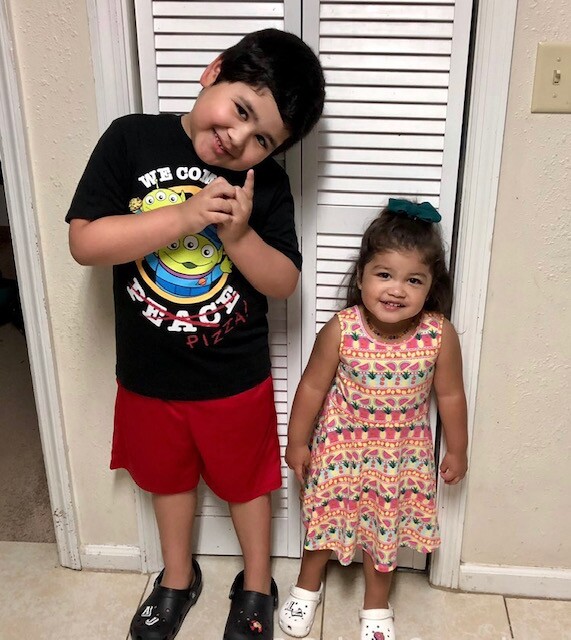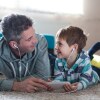Encouraging Inclusion Among Autism Siblings
Eileen Lamb is on the autism spectrum and has two sons, Charlie, who also has autism, and Jude, who does not. “Jude understands that certain situations are overwhelming for Charlie even if they’re not overwhelming to him,” Lamb says. “When things get too loud, [Jude] covers Charlie’s ears with his chubby, little cupped hands to block out the noise.”

Fostering an environment of total inclusion among our children with autism and children who are not on the spectrum is not difficult but it calls for an intentional shift away from mere awareness. It is important to instill understanding, empathy and acceptance with an attitude of “I see you. I value you. You belong.”
For some families, inclusion among autism siblings comes naturally.
Suhay Garcia is another mom to a child on the autism spectrum, AJ, and a young toddler, Lucina, who is neurotypical, meaning someone of typical developmental and cognitive abilities. “AJ and Lucina have this unspoken but unbreakable bond,” Garcia says about her children. “AJ is largely built but very timid. Although Lucina is petite, she will move mountains for her brother. If AJ gets hurt, she is there playing doctor to console him. She tries her best to help him engage and navigate playing environments.”
The same understanding and inclusion is present between Emily Peters’s four children, especially between her oldest son Clay, who is neurotypical, and her daughter Addy Ray, who is on the autism spectrum. “Clay loves his sister so much that he’ll stand like a statue next to Addy Ray,” says Peters, “because he knows she will lose her ever-loving mind if he so much as touches her. Yet he allows her to hang all over him, because even though she doesn’t want to be touched, she needs him to make her feel safe and grounded.”

But encouraging inclusion among autism siblings is not always easy. Sometimes it is something that has to be championed and taught. It can be hard to know where to start. A decade of research and therapy for children on the autism spectrum have shown me helpful ways to foster inclusion between a sibling who is neurotypical and a sibling with autism.
Explain Autism
First, help your neurotypical child understand autism.
Even with a very young neurotypical child, you can use simple language to explain that their sibling who is neurodiverse — or on the autism spectrum — experiences the world in a different way. If their sibling likes to flap their hands really fast when they are excited, you can tell your neurotypical child, “You like to jump and yell out ‘Yay’ when you’re excited and George flaps his hands when he is excited. Isn’t that neat?”
If your neurotypical child is a little older, I like to say that their brother or sister’s brain works a little differently while emphasizing that that’s perfectly okay.

Asahi Bosu, mother of three, tells her children, “Olu is special. Olu has autism.” Naturally, her neurotypical daughter Aya, who is six years old, will ask if she is also special. Bosu confirms this and explains to both Aya and her eldest son, Djimon, “Olu learns in a special way that is different than most people. His brain works differently than ours so sometimes he needs extra help and attention.” She explains to them, “It’s frustrating for him that he can’t always communicate with us, so we have to think about his feelings.” Bosu says Aya in her pure and caring heart understands this and insists she will not be getting married when she is older because she wants it to just be her and Olu. Both Aya and Djimon have wholly loved their brother since he was a baby. “They thought Olu was their baby, “ says Bosu
Read Books
Another way to teach your children about autism is by reading books with them. I have a handful of “go-to” children’s picture books that address autism either directly or indirectly. Samantha Cotterill’s books “This Beach is Too Loud” and “Nope, Never, Not for Me” explain what it can be like to have heightened senses that often lead to sensory overload. These two picture books specifically address noise and food textures and are brilliantly illustrated, which can lead to helpful conversations about autism experiences.
A less direct and more abstract picture book I utilize frequently to help explain autism and discuss inclusion is Nan Forler’s “Trampoline Boy.” The children in this book point and laugh at their neighbor who is constantly jumping on his outdoor trampoline. The children make assumptions rather than try to connect with him. That is, until a little girl named Peaches asks to climb onto the trampoline and jump with him. When she does, she sees what the boy sees and she experiences what he experiences. It’s lovely and smartly done.
I am also the author of a children’s picture book centered around autism and the autism sibling relationship. “My Brother Otto” explores the everyday life between two crow siblings: Piper and her younger brother Otto, who is nonverbal, or not-yet-speaking, and on the autism spectrum. The story is told through Piper’s eyes and is written in kid-friendly language to help even the youngest of readers understand and empathize with autism. Parents of children on the autism spectrum and specialists alike have told me that it is a welcome addition to their children’s libraries.
Model Behavior
After teaching about autism, the second step is to model inclusion in the home.
Wendy Edmondson, mother to son Lucas who is on the autism spectrum and daughter Hadley, says, “I firmly believe that if I want inclusion for my child, inclusion has to start in my own home.”

Our children are watching us and listening to us, right? Get on the floor while your children play and model behavior for your neurotypical child. Say things such as, “Oh! Look at the lights on that music cube. I like that toy,” or, “Let me try to spin, too!” By showing interest, commenting and participating, you are making bids for joint attention — a fancy term for two or more people sharing focus and interest on an object or relative area. Joint attention is the foundation for social language skills, also called pragmatics. Also, you are bonding just by having fun. The other children who are neurotypical in your household will see this and likely will imitate what you did. They want to have fun with their brother or sister too!
Praise Inclusion
The third step for encouraging inclusion among autism siblings is to praise your children when you see inclusion happening in the home.
Speak praises and celebrate with your children when you see them playing together, helping guide or assist one another, or even if they’re just sitting in the same room and getting along. Name the behavior out loud and tell them what they are doing is awesome. Tell them you are proud of them. People are motivated to repeat a behavior when positive reinforcement is used.
These steps are easier said than done, so be patient with yourself and with your children. Inclusion will come. In my experience, I have found that diligent teaching, modeling and praising are very effective starting points.
Love Above All
When I asked parents what they would like people to know about their children who are autism siblings, I received a consistent and resounding message: Their love is like no other! Suhay Garcia says two-year-old Lucina’s favorite thing to say is, “Come on AJ” as she helps him when they are out in public. Garcia explains, “They may not exchange words in a conversation, but the love they have is unique just to them.”

Eileen Lamb says her children’s love does not always use words. “Charlie will occasionally rub his head against Jude, kind of like a cat would do. It’s very sweet.” She asked Jude what he loves about his brother, and he responded, “He’s silly. I love to watch him play. He laughs a lot when I tickle him and that makes me happy. That’s why I love Charlie.”
Wendy Edmondson summarizes it best saying, “Lucas and Hadley have a very typical sibling relationship. They love each other hard and also aggravate each other...hard.” She was worried about how Lucas would handle a new baby in the family. “But she has honestly been the best thing for him,” Edmondson said. “She has taught him in ways what I was never able to, just by being his sister and best friend. Their bond is truly beautiful.”


